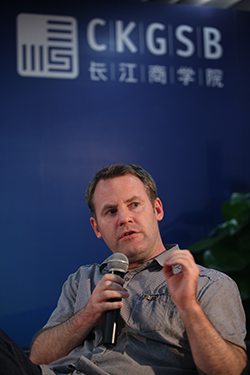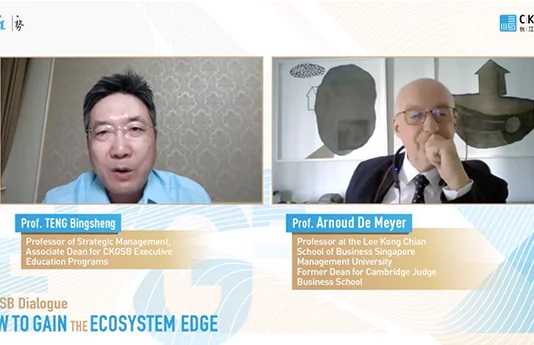A recent global IBM CEO survey says that the majority of CEOs who participated believe the key to navigating today’s uncertain economic climes is creativity. Creating an innovative workplace is an essential part of business today, but implementing practices that actually nurture creativity is much more difficult than supporting it in theory.
Many in the tech industry regard Apple’s approach to innovation as key to their phenomenal success. Apple has consistently carved out new markets where there were none by adding never-before-seen value to existing products. As a result, the Apple stock has grown by an astounding 4,500% in 10 years flat. Apple is a classic case in discovering ‘blue oceans,’ or new markets, a term coined by W. Chan Kim and Renée Mauborgne in their groundbreaking book Blue Ocean Strategy. But for those who are firmly entrenched in crowded markets, or what Kim and Mauborgne call ‘red oceans’, it is not that easy to maintain innovation and creativity as a focal point when the call of the bottom-line is as loud as ever.
During a recent visit to CKGSB (video excerpt from the forum below), Darren Dahl, Professor of Applied Marketing Research at Sauder School of Business in Vancouver, Canada, offered his ideas and insights into the fundamentals of fostering creativity in the workplace in a compelling conversation with Zhang Kaifu, Assistant Professor of Marketing, CKGSB. Excerpts from an interview:
Q. How should a company manage its creative talent in order to achieve innovation?
A. Creativity in an organization starts with hiring. If you are hiring someone to be creative, don’t necessarily hire the same person that you are hiring for the accounting department or the finance department. The creative individual often will break rules, they’ll challenge people, and sometimes they don’t fit in. But that’s what you want, because those are individuals that will give you new insight on how to change the way you are doing business. They’ll make you think about what you take for granted.
The second thing is workspace and environment. What research has shown is that having a cube farm or separated offices isn’t really the best way to facilitate creativity. Creativity occurs when you allow the ‘intersection’ of your workers, you allow them to be physically near one another, to conflict with one another, to have discussions, and really communicate with one another. You don’t want the same people right next to each other. This will be useful because they will be able to provide insights on the way they see the world.
Q. How can companies foster creative and innovative thinking?
A. If you get stuck in a job, you may have been really creative when you started, but after doing it for five or 10 years, you kind of lose your spark. So, if you want creativity in your organization, you have to be dedicated to having some type of training, or activity, or refresher on what it means to be creative. That seems obvious, but it’s not easy to do.
It ranges [from] having the consulting arm of Lego, the children’s building block company from Denmark, to actually come to your company and they’ll have you play with them and build things and create things for a day. That’s just fun, right? But the idea behind that, is it gets you back to being creative, to being a child.
Big companies, Fortune 500 companies, do that because they want to get some of that creativity back in the workplace. That’s one end, which is more of a playful end, to another end, which is utilizing very specific creative tools. There is a book written on creative templates, which forces you and helps you to use metaphors to be creative. It’s a process. Other types of creative processes are Design Thinking or de Bono’s Six Hats. These are structured protocols that help you be creative. Very different than the Lego play, but again, some training to give you ideas on how to get that creativity back in organizations. You have to spend time at it.
Q. How about incentives? Is creativity something we can actually incentivize people for?
A. There is a lot of debate on that. We have done some research. What we’ve found is a huge variation. There is no real pattern. Some companies don’t have incentives. They say its part of why you were hired, we expect you to be creative, whereas other companies have financial rewards. If you produce a patent, for example, you receive some kind of financial reward. Other companies have social rewards, so they are recognized by their peers, or receive a promotion. When we talk about rewards, there are lots of different ways to go.
One thing that we’ve found in some of the research we’ve done is that if you are going to create incentive structures for creativity, your employees have to be very aware of what you mean by being creative, and they have to be given the ability or the training or the know-how to actually reach the finish line. Otherwise they lose their motivation and it doesn’t go well.
Q. How can different players within business ecosystems help firms become more innovative?
A. One of the first things you have to look at is education. Some have argued that our education systems, in North America, in China, around the world, aren’t that conducive to creativity. What is easy to measure is analytical thinking, critical thinking. Training to write a GMAT test or an SAT or an IQ, these types of structured thinking have dominated in our early years. We get into very rigid testing systems that eliminate the creative ability. A lot of people feel that we are much more creative when we are young, then the school system kind of beats it out of us. That’s where we have gone wrong. That the more standardized you become as an individual, [the more] you give up creativity.
In China, [people] are very good at taking an idea and making it better, but coming up with that idea is where they need to grow. Some would say education is where it starts.
Q. What are the elements in the other education systems, such as in North America, which actually preserve or encourage this creativity?
A. What is interesting is that the American education system feels that they are losing creativity. That’s what they think themselves.
What I would say is there is a greater appreciation for finding yourself, for trying different types of courses, not being so focused. It’s more about having an experience and truly trying different things, being experimental.
[There’s also] the notion that you should travel. Recent academic research has said that people who travel more to other countries are more creative, because they see different things, different cultures. Being open and exploring different cultures, and seeing the way people do different things, is only going to help you try new things and add new ideas to your society.
When you think about China, it is certainly now opening up over the last 10 or 15 years, [they have] much more ability to see the world, to have their try at different things. I think that’s only going to increase, moving forward.
Professor Dahl spoke about creativity at the CKGSB Global Thought Leaders on New Marketing Trends forum on 26th June 2012 in Beijing. Below is a video of his presentation:

















